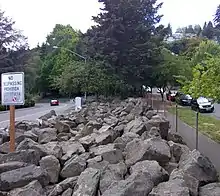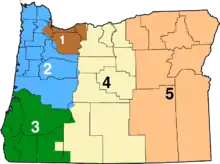Oregon Department of Transportation
The Oregon Department of Transportation (ODOT) is a department of the state government of the U.S. state of Oregon responsible for systems of transportation. It was first established in 1969.[1] It had been preceded by the Oregon State Highway Department which, along with the Oregon State Highway Commission, was created by an act of the Oregon Legislative Assembly in 1913.[2] It works closely with the five-member Oregon Transportation Commission (the modern name of the Highway Commission) in managing the state's transportation systems.
.svg.png.webp) | |
| Agency overview | |
|---|---|
| Formed | 1969 |
| Preceding agencies |
|
| Jurisdiction | Oregon |
| Headquarters | Salem, Oregon |
| Agency executive |
|
| Parent agency | Oregon Transportation Commission |
| Website | www.oregon.gov/ODOT |
The Oregon Transportation Commission, formerly the Oregon State Highway Commission, is a five-member governor-appointed government agency that manages the state highways and other transportation in the U.S. state of Oregon, in conjunction with the Oregon Department of Transportation.
Inception
.jpg.webp)
.jpg.webp)

The first State Highway Commission was created on August 12, 1913, and was composed of Governor Oswald West, Secretary of State Ben W. Olcott and Treasurer Thomas B. Kay. On January 12, 1915, James Withycombe became Governor and replaced Oswald West on the commission. The 1917 Oregon Legislative Assembly redesigned the State Highway Commission, with citizens appointed to replace the elected officials.
The new commissioners held their first meeting on March 6, and the commission was then known as the Oregon Highway Division. As Oregon's transportation needs started to grow, the division expanded and, in 1919, it employed their first State Bridge Engineer, Conde McCullough.
Events
By 1920, Oregon had 620 miles (998 km) of paved roads and 297.2 miles (478.3 km) of plank roads for a population of 783,389 and, by 1932, the work that had been started on the Oregon Coast Highway (also known as U.S. Route 101) in 1914 was completed, except for five bridges, which meant greater responsibility for the division. This work was complete when the construction of the bridges over the Yaquina, Alsea, Siuslaw, and Umpqua rivers and Coos Bay were completed, closing the last gaps in the highway. By 1940, the highway division was managing more than 7,000 miles (11,300 km) of state, market and country roads in Oregon, with nearly 5,000 miles (8,000 km) being hard-surfaced.

In 2018, the city government of Portland, Oregon and ODOT entered into an intergovernmental agreement in which the Portland city government takes over the cleanups of transient camps on ODOT right-of-way in select locations in Portland in exchange for payments from ODOT.[3][4]
In 2019, ODOT installed boulders at five locations in Portland to deter transient camps around the freeways. The installations have received support from neighbors while criticized by homeless advocacy groups, [5] as well as eliciting a public criticism by a Portland commissioner Jo Ann Hardesty.[6]
Exploding whale incident
On November 12, 1970, the department was tasked with disposing a dead sperm whale that washed ashore Florence beach. The department exploded the dead whale using half a ton of dynamite to blast it off the beach. Pieces of dead whale went everywhere including the beach, bystanders, a parking lot and a park, severely damaging at least one car.[7] Willamette Week reports "The decision to publicly dynamite an enormous mammal has become one of Oregon's all-time most bizarre moments."[7]
This became known as the "exploding whale incident".[8]
Directors
- John Fulton — July 1, 1969 – December 31, 1970
- George Baldwin — January 1, 1971 – June 30, 1971
- Sam Haley — July 1, 1971 – July 8, 1973
- George Baldwin — July 9, 1973 – April 30, 1976
- Bob Burco — May 1, 1976 – January 8, 1979
- Fred Klaboe — January 9, 1979 – December 31, 1981
- Fred Miller — January 1, 1982 – February 16, 1987
- Bob Bothman — February 17, 1987 – June 30, 1991
- Don Forbes — July 1, 1991 – 1995
- Grace Crunican — 1996 – 2001
- Bruce Warner — 2001 – 2005
- Matthew Garrett — December 19, 2005 – June 30, 2019
- Kris Strickler — September 2019 – Present
State Highway Engineers
- H.L. Bowlby — June 3, 1913 – March 31, 1915
- E. I. Cantine* — April 1, 1915 – May 21, 1915
- John L. Lewis — May 22, 1915 – August 27, 1915
- E. I. Cantine* — August 28, 1915 – January 19, 1916
- John L. Lewis — January 20, 1916 – April 10, 1917
- Herbert Nunn — April 10, 1917 – March 31, 1923
- Roy A. Klein — April 1, 1923 – February 28, 1932
- R.H. Baldock — March 1, 1932 – August 15, 1956
- W.C. Williams — August 16, 1956 – November 30, 1961
- Forrest Cooper — November 30, 1961 – June 30, 1970
- R.L. "Rod" Porter — July 1, 1970 – December 31, 1971
- Tom Edwards — January 1, 1972 – December 31, 1972
- I. Fred Klaboe — January 1, 1973 – May 31, 1976
- H. Scott Coulter — June 1, 1976 – August 4, 1985
- Lawrence W. Rulien — September 9, 1985 – January 1, 1988
- Don Forbes — February 22, 1988 – January 31, 1992
- Bill Anhorn — February 1, 1992 – 1993
- Ken Husby — 1993 – 1997
- Tom Lulay — 1997 – 2001
- Cathy Nelson — 2001 – 2013
- Tom Lauer — 2013 – 2017
- Steve Cooley — 2018 – present
Slogans
- 1913 - "Get Oregon Out of the Mud"[9]
- 1957 - "Building Oregon Thru Better Highways"
- 1958 - "Oregon Freeways...Symbol of 2nd Century Progress"
- 1961 - "Freeways are Easier"
- 1967 - "Fifty Years of Building Better Highways in Oregon" (not technically correct; the department was formed in 1913)
- 1978 - "Keep Oregon Green and in the Black"
- 1986 - "ODOT on the Move"
- 2006 - "The way to go!"
See also
- Glenn Jackson, an influential twenty-year member of the commission
- Oregon Department of Aviation
- State highways in Oregon
References
- History of ODOT
- Department of Transportation: Agency History, Oregon Blue Book.
- Sparling, Zane. "ODOT to pay Portland for homeless camp clean-ups". Retrieved 2020-07-23.
- Harbarger, Molly (2018-12-20). "Portland taking over homeless camp cleanups for ODOT". oregonlive. Retrieved 2020-07-23.
- Kruzman, Kruzman (2019-07-04). "Portland's homeless campers face new obstacle: piles of boulders". oregonlive. Retrieved 2020-07-23.
- "ODOT responds to Commissioner Hardesty's criticism: Boulders are for safety, cost-effective". kgw.com. Retrieved 2020-09-07.
- June, Sophia (October 3, 2016). "There Is Now Better Footage of That Time Oregon Blew Up a Whale With Dynamite". Willamette Week. Retrieved 2020-07-23.
- "Exploding Whale Memorial Park to Honour Blubber That Was Blown to Bits in US 50 Years Ago". News18. Retrieved 2020-07-23.
- Business Services History Center Archived 2012-01-02 at the Wayback Machine